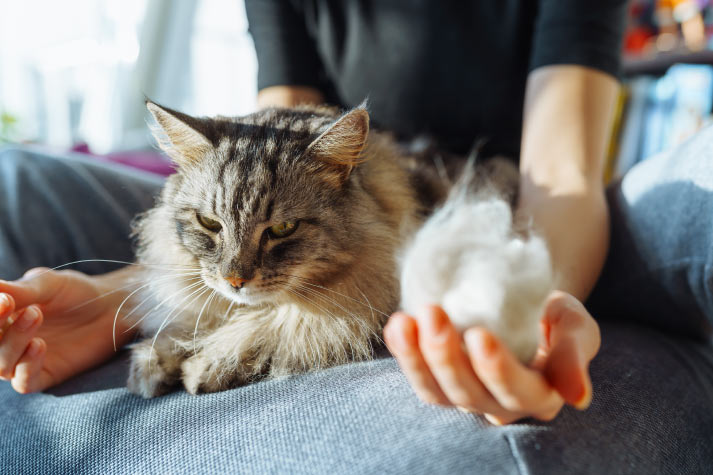Cat Hairballs: Origins and Solutions
Living with cats has many upsides, but hairballs are not one of them. If you’ve ever owned a cat, you probably know that distinctive sound, a series of low hacks followed by a small mess on the floor. While common, they can worry anyone who cares deeply about pet health and is striving for better cat care.
What is a Hairball Anyway?
Hairballs, technically called trichobezoars, are just clumps of hair your cat swallows during self-grooming. Most of the time, the fur whisked away by their sandpapery tongue passes smoothly through the digestive system. Occasionally, though, it gathers together and comes out the wrong way, in a very memorable fashion.
Why Do Hairballs Happen?
- Grooming Habits - Cats naturally lick themselves a lot. Their tongue’s rough texture is perfect for cleaning but also makes swallowing loose fur almost unavoidable.
- Breed Differences - Long-haired cats like Persians or Maine Coons seem to produce more hairballs than their short-haired cousins.
- Season Shifts - Cats shed more during spring and fall. If you notice more fur on the sofa, expect a spike in hairballs.
- Stress and Health - Sometimes, cats over-groom if they’re feeling stressed, bored, or dealing with skin problems. Keeping their environment enriched and relaxed helps more than you might think.
When to Worry about Hairballs
Most hairballs are harmless, even if they’re a hassle to clean up. But persistent gagging, vomiting without result, lethargy, or a swollen belly are red flags. If your cat stops eating or has trouble pooping, see your pet vet. Keeping track of these signs is an important part of overall pet health.
- Brushing and Pet Grooming - Frequent brushing is the best way to beat too many hairball formations. Also, brushing turns into special bonding time with the cat. Remember to collect the loose hair to prevent future hairballs. Find a routine that suits you and your cat’s schedule.
- Choosing the Right Diet - Some foods help digested fur move along more easily. Some pet-recommended hairball formulas can show improvements. Foods with extra fiber or added oils reduce shedding and make the digestive tract less likely to clog.
- Using Remedies - While there are gel products and treats designed for cats prone to hairballs, always check with your pet’s vet before switching things up. These can lubricate the gut so hair doesn’t get stuck.
- Hydration - Cats sometimes forget to drink water, especially during travel. Placing water bowls around the house and even using a pet fountain can be helpful. Staying hydrated helps everything run smoother in their system.
- Stress Busters - Boredom can lead to obsessive grooming. Keep feather toys, puzzle feeders, and dedicated playtime each day to keep your cat mentally engaged.
Travelling With Cats: Hairball Prevention on the Move
If you’re ever planning international pet travel, or any trip with your feline, a little extra preparation goes a long way. A thorough brushing session before leaving is really important. Carrying the cat’s favourite treats and sticking to familiar foods avoids any digestive surprises during the journey. Pets can get anxious during travel, and extra grooming helps keep hairballs at bay.
Quick Tips for Every Cat Parent
- Make time for weekly brush sessions.
- Ask your vet about diet tweaks, especially during shed-heavy months.
- Provide lots of fresh, cool water.
- Keep your cat’s routine steady; travel and changes at home can affect their grooming habits.
- Watch for repeated gagging or vomiting. When in doubt, call your vet for advice.
Beyond Hairballs: Looking Out for Your Cat’s Health
Hairballs can be more than just a nuisance; they’re a signal about your cat’s overall well-being. By focusing on daily pet grooming, healthy eating choices, and emotional enrichment, you’ll help your cat thrive. A little effort goes a long way in keeping hairballs out of your favorite spots.
Final Thought:
Cats, with their elegance and quirks, have habits we simply learn to manage, hairballs being one of them. Regular brushing, a balanced diet, proper hydration, and keeping an eye on any changes in behavior can go a long way in preventing hairball troubles. Every cat is different, and getting to know their quirks is part of the fun. Stay attentive to changes, ask plenty of questions, and, above all, enjoy the wonderful company your cat provides.




AUTHOR’S BIO
Shivangi Lawania
Storytelling is my way of bringing ideas to life. I enjoy shaping words that spark curiosity and connection, while keeping a strong focus on branding and communication. For me, great content blends creativity with clarity to leave a lasting impression.